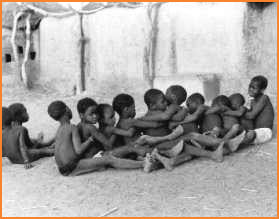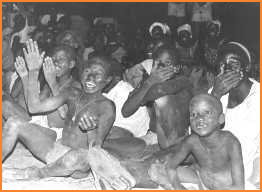
Village boys and girls play a dance-game. Weaving from side to side, the children sing emphatically that people should refrain from ruining the reputations of innocent people.
16mm. Color. 3 Hours.
In Post-production.
Seeking Completion Funding.
Filmed in the Sahelian region of West Africa, in Burkina Faso.
In Moore [pronounced “mo ray”], language of the Moose [pronounced “mo say”].
Subtitled in English.
Filmed over a span of two decades, in the Sahelian region of West Africa, ZAKARAMBA, a Family for All Seasons presents an intimate portrait of three generations of an extended Moose family of farmers and their community in the struggle for survival, through a seven year drought, a bumper crop and subsequent crop successes and failures.
The film follows the Balma family, focusing on how children, parents and elders participate in agriculture and daily and seasonal activities, and how they perceive community, the environment and life itself. The Balmas, often with relatives and neighbors assisting, engage in communal work throughout the entire agricultural cycle: clearing the fields, planting new crops, weeding and cultivating the millet, sorghum, corn and bean fields, harvesting, threshing and winnowing the grain.
 Seeing your friends, relatives and self on the silver screen during a village screening of scenes from the film. For most this was the very first motion picture experience. |
From an early age, children learn and practice responsibility, reciprocity and sharing. At age 5, Lwizi has her own peanut field. At age 7, Piaara walks four miles to grade school each morning and upon returning home, joins younger brother Andre tending to the family sheep and goats. Sister Sofi helps her Mom pull buckets of water from the village well, carries a bucket of water on her head, all the way home, and prepares millet porridge for the family.
Older brothers, Cyprien and Lwi, herd the family’s cattle from sunrise to sunset, through the intense midday sun, dust storms, thunder and rainstorms, guiding the cattle to a water hole, making sure they stay out of village crops.
At times, relatives and farmers from surrounding villages gather to assist the family at kobo (hoeing), ki-kiabo (harvesting), ki-pabre/ki-webo (threshing/winnowing) work parties, performed to the rhythm of drums, with chanting and the gorgo dance.
ZAKARAMBA demonstrates the integral relation of music, dance and oral tradition to year-round communal work, celebration and rites of passage. Through filmed interviews, elders, parents and children speak directly to the viewer about family, community, subsistence farming, tradition and the modern world, beliefs and hopes for the future.

 Follow
Follow